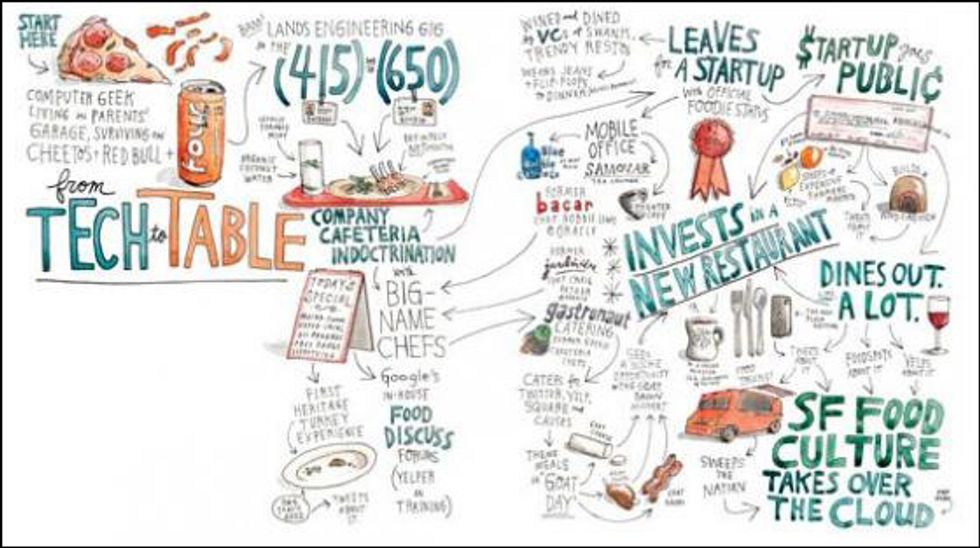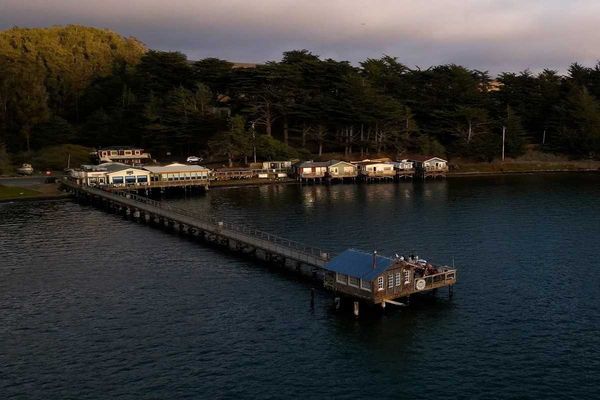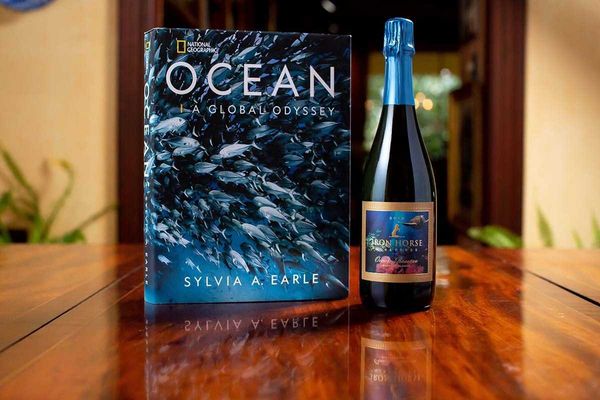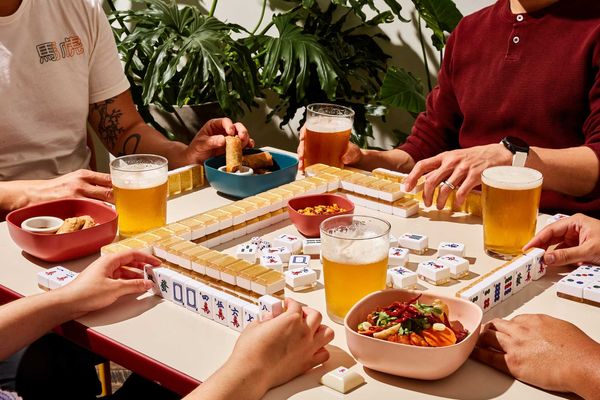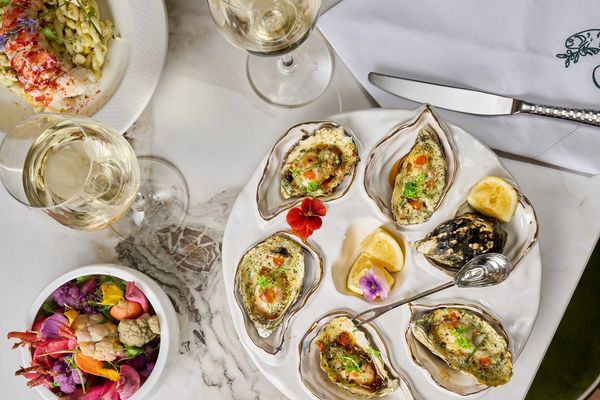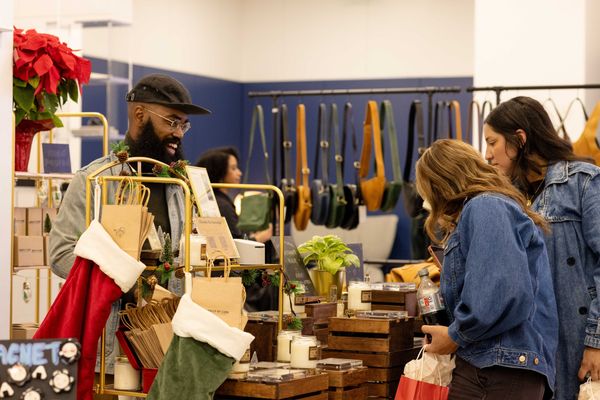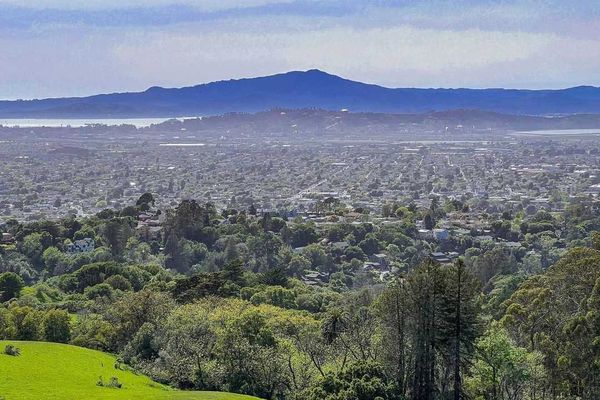A few months ago, Jamie Oliver—the charismatic English chef whose star power can be measured by his 1,258,908-and-counting Twitter followers—stepped out of a black town car to have dinner at quaint, little Bar Jules.
I acted cool, of course—totally blasé about the fact that my husband, who’s long had a man crush on Oliver, and I had been invited impromptu by Bar Jules’ chef and owner Jessica Boncutter to join her at Oliver’s table. I expected mayhem and fainting, but the Hayes Valley restaurant was so crammed with people that only a few took a second glance at the normal-looking guy in jeans, a plaid shirt, and a trucker cap, weaving his way through the crowd.
More under the radar, but perhaps as influential, was the group of young, local tech elites Oliver had come to dine with: Chris Sacca of Lowercase Capital, one of the initial investors in Twitter and the baby of the Forbes 2011 Midas List; Joe Green, cofounder of charitable donation site Causes (and, perhaps even more famously, former Harvard roommate to Mark Zuckerberg); Kevin Rose, founder of Digg and the new app development lab Milk; and Mike Krieger, cofounder of the popular photo app Instagram, which since its 2010 launch has acquired more than 5 million users. Green set up the dinner after meeting Oliver at the 2010 TED conference. Platters of Boncutter’s impeccable beef short ribs with salsa verde were passed family style, as were multiple bottles of red wine.
The company at this dinner was an equally good pairing. Oliver has long been hip to social media—he incessantly tweets, has his own YouTube channel, and has produced Webby-winning apps. But that night, Oliver was pissed. ABC had just canceled Jamie Oliver’s Food Revolution and—adding insult to injury—replaced it with Dancing with the Stars recaps, eliminating the third series of the do-good show wherein Oliver attempted to help America with its obesity epidemic and show kids what chicken nuggets are really made of. After dinner, Oliver told me he was determined to make a go of it without the network, and keep his message out there by any technological means possible.
The next day, back in England and just in time for the royal wedding, Oliver’s tweets started to scroll: “@sacca: Great night of chow, ideas, and inspiration with: @crystale @Kevin @mikeyk @summertomato @kevinrose #FoodRevolution.” He also started snapping pics of dishes like lemon tagliolini using Instagram and celebrated his birthday by asking his devoted online followers to donate $25,000 to his food revolution using Causes.
Thanks to Alice Waters—who, in March, finally entered the Twitter fray herself—delicious revolutions are a dime a dozen around the Bay Area, but I’d say that we’re currently experiencing something more akin to a food renaissance. In my 15 years of writing about food in SF, I’ve never witnessed such a vibrant, creative scene. There seem to be more farmers markets, more variety of restaurants, and more types of food venues (pop-ups, trucks, carts) than I can ever recall. San Franciscans are eagerly lining up for all of it, and even national food writers are waxing poetic. In July, Alan Richman of GQ called San Francisco the “most exciting place in American dining right now.”
Yes, it’s about our mix of proximity to wonderful ingredients, righteous chefs, and enthusiastic home cooks. But a big part of our insatiable appetite—and more critically, what sustains it—might not have anything to do with food at all. That night at Bar Jules was just a tasty slice of what happens when food and technology mix.
I hadn’t considered the synergy between SF’s two biggest cultural pillars until recently. It took dining at Bar Tartine with a friend who wishes to go unnamed—a tech venture capitalist invested in some of the city’s top restaurants. That night, when I started talking in wonderment about the surge of restaurant openings in SF, recession be damned, he politely suggested I get my head out of my dinner. “What boils my blood,” he said, between bites of duck leg cabbage roll stuffed with liver, house-made sauerkraut, and dried cherries, “is that people in the artist community have never understood the connection between capital and the arts. And they take it massively for granted.”
Gesticulating with a curried, pickled carrot, he broke it down historically. “Look at the rise of Florence. During the Renaissance, you had the combination of wealthy patrons and artists. The wealthy patrons allowed the artists to take risks that they’d never have been able to take if they weren’t provided for.” While sommelier Alex Fox poured us some Von Buhl Riesling, he continued, “And it’s no different today in San Francisco, where food has crossed over into an artistic experience. Chefs and bartenders here consider themselves artists.” I had a disconcerting flash of Bar Agricole’s acclaimed bartender Thad Vogler posing naked like Michelangelo’s David, shaker instead of stone in hand. “Even farmers have artistic status here,” my friend astutely observed. “Today in San Francisco, the wealth gets poured back into our modern-day values: the church of food.”
That wealth is immense. The Bay Area is one of the most prosperous regions in the world. This stems largely from the dynamic technology sector that is showing no signs of stopping its meteoric rise. This spring, Apple was valued at roughly $301 billion. Facebook, in just five years, has gone from $5 million to upwards of $100 billion. Google is now estimated to be worth $164 billion, Twitter $10 billion, Zynga $7 billion. LinkedIn, when it went public in the spring, soared from $5 billion to $10 billion in 24 hours.
These staggering financial numbers might seem far and away from a hot kitchen where line cooks get paid $11 an hour, but for a chef raising money to open his or her dream restaurant—or even the farmer selling his $5-a-pound O’Henry peaches—the proximity to the people making these kind of mind-boggling profits can be very helpful. Potential investors—those folks who have made a nice chunk of change from a startup here—often find themselves drawn to put their money where their mouth is, even if the return garners only social status at first.
“At a time when I was finally looking to diversify, I asked my financial advisor what he thought of the idea of investing in restaurants,” says YouTube cofounder Steve Chen, sitting in the Ritz-Carlton Residences’ common room with Muzak on the speakers overhead and his backpack thrown on the couch. “My advisor said, ‘That’s not an investment. That’s paying for a passion.’”
This didn’t deter scruffy, spiky-haired Chen, who admits that he grew up in Illinois, eating less-than-adventurous food: “Coming to California was like going to elementary school for culinary appreciation.” Not to mention the fact that things change after you sell your company to Google for $1.65 billion. I imagine Chen might have been the guy eating Hot Cheetos to make it through an overnighter before he was the guy jetting around the world to promote Google, tasting the foods of every country, and being presented with $1,000 bottles of wine. “But most of the time, I’d still rather just have a Pepsi,” admits Chen, who is charmingly modest.
Today, Chen’s Twitter account photo shows him transferring a pizza into the wood-fired oven at his house in Napa. He’s invested in restaurants including Sightglass Coffee, Quince, and Benu—the latter two are some of the most well-regarded fine-dining restaurants in the country. “I got invited to someone’s house for a hot pot party in Napa,” says Chen, recalling how he met Corey Lee, chef-owner of Benu. “I thought it would be casual, but when I arrived, there was Corey, who had just put in his resignation as the chef de cuisine of The French Laundry, and like the entire staff of the restaurant. We had lobster and good wine. Those chefs seemed like mythical characters who operate on a different frequency than I do.”
That would be an understatement. Chefs notoriously avoid their email and stand on their feet all day, sweating over live fire. Computer engineers spend their lives in a climate-controlled, fluorescent-lit room, glued to a computer. While chefs directly affect the number of diners they can physically serve from their kitchen, people like Chen affect millions all over the world with the touch of a keyboard. Jason Portnoy, the CFO of Practice Fusion, an electronic medical record community, and the former VP of financial planning for PayPal, is another restaurant investor in town. “You know you’re having an impact on the world, but sometimes it feels really intangible,” he says. “But take that money and invest it in a restaurant and it allows you to see the physical manifestation of it—not to mention you now have a place where you can have fun and be social over a meal.”
The hot pot introduction that night led Chen to invest in Benu—a beautiful restaurant that exemplifies an artistic experience. The food is by no means a lobster-and-caviar slam dunk. The tasting menu reads more like an Asian-inspired food haiku (thousand-year-old egg, nasturtium, ginger). Benu opened this past fall, on the cusp of the darkest days of the recession. Although not exclusively due to Chen’s investment, Lee had enough financial support to forge ahead, garnering the city—which has long been criticized for its lack of fine-dining chops—a gush of accolades for its new, modern, and experimental restaurant. (See July’s GQ.)
Lindsay Tusk, the co-owner of Michelin-starred Quince, and Lee share Chen as an investor. Tusk estimates that about 75 percent of the Quince investors are from tech. “The tech VCs have a general optimism and desire to shepherd an idea into the world,” she says. “Honestly, I think that’s why they’re interested in restaurants—because there’s certainly not the normal return.”
The funding side of the equation isn’t the only place where technology affects our restaurants. It’s also quite possible that its influenced our jeans-are-always-acceptable Nor Cal dining dress code. Unlike New York, say, where Wall Street funding comes with the buttoned-up, old-money culture of suits and secrecy, the tech world is about backpacks, flip-flops, and oversharing. “The engineers are definitely more casual than the VCs,” says Tusk, who points out that her VC investors bring to her restaurant the people from the startups that they’re looking to support. In a trickle-down effect, those people are likely to become the restaurant’s returning guests.
It’s a younger group too. Lee has the perspective to compare Benu, which has a lot of the 650 Silicon Valley area code on the reservation books, to his time at The French Laundry, whose patronage is largely made up of out-of-town visitors. “The biggest difference is that here in San Francisco, I have a clientele that’s fairly young for an expensive restaurant like Benu,” he says. “When I worked in New York, the wealth was so up and down on a daily basis because of the stock market. You’d see people spending $12,000 on wine in one night. Not so much here.”
You could also say that the modern-day place setting—fork, spoon, knife, iPhone—was born here. The propensity to snap a picture of every one of Benu’s 18 courses to post on Foodspotting is something Lee never witnessed in New York. And then there’s Yelp. “Look at the Yelp reviews of [former French Laundry chef] Jonathan Benno’s Lincoln Restaurant in Lincoln Center,” says Lee. “There are so few of them.” (At press time, 38 to be exact.) “But at Benu we have a ton.” (At press time, 175.) “Everyone here wants to share their experiences online.”
At this point, the food and technology equation starts to get murky—kind of a question of the heirloom chicken or the pastured egg. Which came first: the inclination or the application? It’s no coincidence that the platforms we use to share our food experiences were born here: Twitter, Foodspotting, Yelp, Instagram. Add to that Chow, which long ago swallowed up Chowhound (the original name for “foodie”), and even OpenTable—the entryway to all dinner reservations—which started in the Bay Area in 1998.
Regardless of the answer, the result is clear. San Francisco diners and their groans of delight over the latest pork belly manifestation are constantly being projected into the social media ether. That in turn brings in more salivating diners. National publications fish from the Internet too. Recently, both Food & Wine and the The New York Times wrote about Mission Chinese Food—a restaurant that founder Anthony Myint admits came to fruition largely because of Twitter—and you can rest assured it wasn’t because someone tipped the editors off with an old-fashioned phone call.
It might just be that the inclination to Yelp is cultivated at places like Google’s Mountain View campus. On one of its many in-office online forums called Food Discuss, employees do everything from critique the latest Google cafeteria offerings to share recipes for Parmesan chicken. Preeti Mistry, former Top Chef candidate and now the owner of Juhu Beach Club, worked for a year as the executive chef of Charlie’s Café, the largest cafe at the Google campus. “The employees are nerdy, straight-out-of-college 20-somethings,” she says. “Many of them were probably eating mac and cheese from a box until they went to work for Google. I remember when we served Bill Niman heritage turkeys around Thanksgiving. We put posters out explaining what they were eating so they understood where it came from. It’s got to be an awakening.”
Mistry is just one of the city’s chefs who have been recruited to work at fancy tech cafeterias. Craig Patzer migrated from Jardinière to take Mistry’s place when she left Charlie’s in April 2010. Robbie Lewis, formerly of Bacar, is now at Oracle. In other words, the culinary lessons these Silicon Valley kids are learning aren’t coming from your stereotypical cafeteria food slingers.
This is what John Dickman, the new Café Services Program Manager of Intel and the new president of CUESA (Center for Urban Education about Sustainable Agriculture), knows to be true. Initially brought in by Google to set up its cafeteria, Dickman remembers the game-changing moment well. “I sat down with Larry [Page] and Sergey [Brin] and they said, ‘We want you to make great food and go out and find great restaurant chefs to do it.’ We opened 30 cafes in 30 months,” says Dickman. “We were touching a lot of lives. We really didn’t know how big we were going to get. A bunch of my friends said I was crazy to work with this startup.” Today, the bar that Google set for its food programs has now been embraced as a given benefit of a job in name-brand tech.
In SF, Gastronaut, a catering company started by two former Google chefs, has become the go-to caterer for SF’s A-list companies, including Twitter, Causes, Yelp, and Square. On a Monday afternoon, I walk over to the SoMa offices of Square, a company that makes credit card readers for phones and iPads, to experience one of their thematic lunches. Unfortunately, I’ve missed goat day (roasted goat, goat cheese) but I’m lucky enough to arrive just in time for Portuguese day, which includes coconut-braised kale, rosemary and lemon pork stew, and black-eyed pea salad with hard-boiled eggs. The menu, of course, bears the ubiquitous “seasonal, local, and organic” disclaimer.
Founded by Jack Dorsey, the co-founder of Twitter and also an investor in Sightglass Coffee, Square is everything you’ve ever envisioned about a startup: youthful faces are lit up by glossy Mac monitors, and a wall fixture is scrolling with tweets. There’s midcentury furniture, comfy couches, lots of cold cereal choices, an in-house dodgeball team, movie nights, and guac o’clock (3 p.m. guacamole and chips—“We’ve developed a Pavlovian response to it,” one engineer jokes).
Everyone here eats together for lunch and quite often for dinner. With food that’s this good, not to mention free, they even come in to the office to eat on weekends, for the social aspect if nothing else. Most don’t buy groceries—there’s really no need. However, one thing does draw them from the nurturing womb of their workplace: a food truck. On Wednesdays, Off the Grid parks near the office. Many of the vendors use Square to do their credit card transactions, so it’s a good excuse for the staff to get outside to eat.
Of course, the food truck movement couldn’t have taken off without Twitter, I explain excitedly, expecting them to find my food-tech-codependence theory as revelatory as I do. But these 20-somethings, working for a company that TechCrunch rumored to be worth around $240 million in June, don’t see themselves as foodies-in-training who might make billions one day and then invest in a local restaurant, continuing to propel SF’s food world forward. For them, the Twitter connection is more of a duh moment. They’re too far enmeshed to see outside of this world. To them, this is not a renaissance. It’s just lunch.
*Originally published in 7x7's August issue, on newsstands now. Subscribe here.




